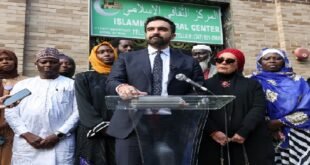25-06-2020
By SJA Jafri + Bureau Report
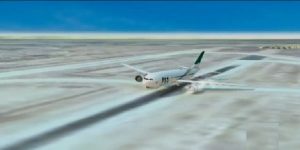 ISLAMABAD/ KARACHI/ LAHORE: Federal Minister for Aviation, Ghulam Sarwar Khan presented the interim investigation report on the Pakistan International Airline (PIA) plane crash in the National Assembly on Wednesday, saying that the pilots were not focused and their lack of concentration caused the crash.
ISLAMABAD/ KARACHI/ LAHORE: Federal Minister for Aviation, Ghulam Sarwar Khan presented the interim investigation report on the Pakistan International Airline (PIA) plane crash in the National Assembly on Wednesday, saying that the pilots were not focused and their lack of concentration caused the crash. Presenting the initial investigation report on the floor of the House, Sarwar said that the conversation between the pilot and the air traffic controllers had been recorded and he had heard it himself.
The minister said that the equipment from the aircraft had been extracted and decoded, adding that the recording obtained would be made part of the final report of the plane crash.
Sarwar said that the initial report pointed out that there was no technical fault with the aircraft and even the pilot had said the same in his conversation with the air traffic controllers.
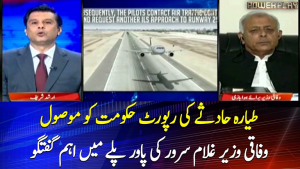 Touching upon the details of the compensation provided to the affectees, the aviation minister said 29 houses had been damaged in the crash and the inquiry board was shown the damage.
Touching upon the details of the compensation provided to the affectees, the aviation minister said 29 houses had been damaged in the crash and the inquiry board was shown the damage.
“Those whose houses were damaged in the plane crash have been compensated and are being compensated. They have been given temporary shelter,” he said.
The federal minister added that authorities were trying to compensate the 90 families that had been affected by the tragedy and those who had suffered on the ground as well. “Those who were injured on the ground have also been compensated,” Sarwar added.
Speaking about the aircraft, Sarwar said that no technical fault could be found in it. “Because of the coronavirus, flights had been suspended. The plane took the first flight after operations resumed on May 7 and between then and May 33, the plane completed six flights,” he said.
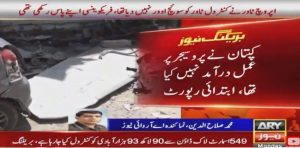 “Five flights were from Lahore to Karachi and Karachi to Lahore, while one flight was to Sharjah,” the minister told the Parliament. He added that both the captain and his co-pilot were medically fit to fly as well.
“Five flights were from Lahore to Karachi and Karachi to Lahore, while one flight was to Sharjah,” the minister told the Parliament. He added that both the captain and his co-pilot were medically fit to fly as well.
He continued, “I spoke to one of the survivors and one of them told me that after the plane crashed onto the roof of the house, he was still strapped to his seat while he bounced from one floor of the house to another and was eventually rescued when he landed on the first floor.”
Talking about the crash, the minister disclosed that the aircraft touched the runway thrice without the landing gear which caused damage to its engines. “When the plane took off again, both its engines had been damaged,” he said.
He added that the initial report mentioned that the plane’s data entry record showed that as the plane was 10 nautical miles from the runway, its landing gears had opened.
“But the one thing that cannot be explained is that when the plane was at five nautical miles away, the landing gears were pulled up. This action is also there in the data recorder,” said the minister. He added that whenever a plane comes close to landing, it has to be provided a flexible position.
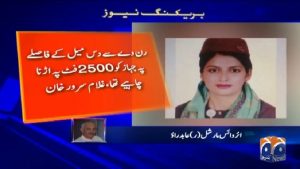 The minister told the House that while assessing the two most “important evidence” from the flight data recorder of the DFDR, in which all actions of the plane are recorded, and the cockpit voice recorder, the “first irregularity” was noticed when the pilot approached the runway.
The minister told the House that while assessing the two most “important evidence” from the flight data recorder of the DFDR, in which all actions of the plane are recorded, and the cockpit voice recorder, the “first irregularity” was noticed when the pilot approached the runway.
“The plane was supposed to be at the height of 2,500 feet at 10 nautical miles before coming near the runway. According to the initial report and the record, the plane was at a height of 7,220 feet. This is was the first irregularity,” said the minister.
He added that the air traffic controller (ATC) reminded the pilot thrice that his aircraft’s height was much higher than the recommended limit and advised him not to take the landing position and instead, take another round of the airport.
The minister said that when the pilot was informed about the dangerous height at which the aircraft was, he did not pay heed to it and said that it would be ‘managed’.
“The fault was at both ends. The ATC was at fault as well when it saw the plane doing the touchdown on the engines and saw a fire erupting, it should have informed [the pilot] but the control tower did not. And when the pilot took off, both the engines were damaged by that time,” the minister said.
Sarwar said that the pilot and the co-pilot were not focused and their lack of concentration had resulted in the plane crash. The minister added that the pilots were discussing the coronavirus as it had affected their families and were not paying attention to their job.
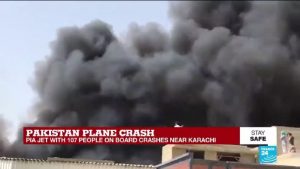 The minister said that it was observed that the pilot took the call “very hurriedly” and told the tower that he would “manage”. He added that recorder showed that even after taking the call the pilots went back to their conversations about coronavirus.
The minister said that it was observed that the pilot took the call “very hurriedly” and told the tower that he would “manage”. He added that recorder showed that even after taking the call the pilots went back to their conversations about coronavirus.
“The pilot then again requested another approach but unfortunately the approach he was given and the height he was given, it [aircraft] could not reach there and crashed on the civilian population,” said the minister while explaining what the report said about the final minutes of the plane.
The federal minister further said that the cabin crew and ATC were also responsible for the tragedy. “Those who have passed away, may God forgive them. Those who are alive and are responsible will be held accountable,” he added, promising that the complete investigation report will be presented in a year’s time.
He said that the Bhoja air crash and the Air Blue tragedy had been caused as a result of the pilots’ faults as well.
The minister said that 40% of pilots were flying aircraft with fake licenses.
“Pakistan has 860 active pilots, which includes PIA, Serene Air, Air Blue. The inquiry which was initiated in February 2019 showed that 262 pilots did not give the exam themselves and asked someone else to give it on their behalf,” the minister said, adding that the pilots did not have the proper flying experience either.
“Pilots are also appointed on political basis, unfortunately,” he said. “Whilst appointing pilots, merit is ignored,” he added, disclosing that degrees of four PIA pilots had been found to be fake.
Sarwar said that the government will take action against pilots who were found guilty of the above offenses. He said that the government will ‘restructure’ the PIA and will take it back to its days of glory.
 Pressmediaofindia
Pressmediaofindia




